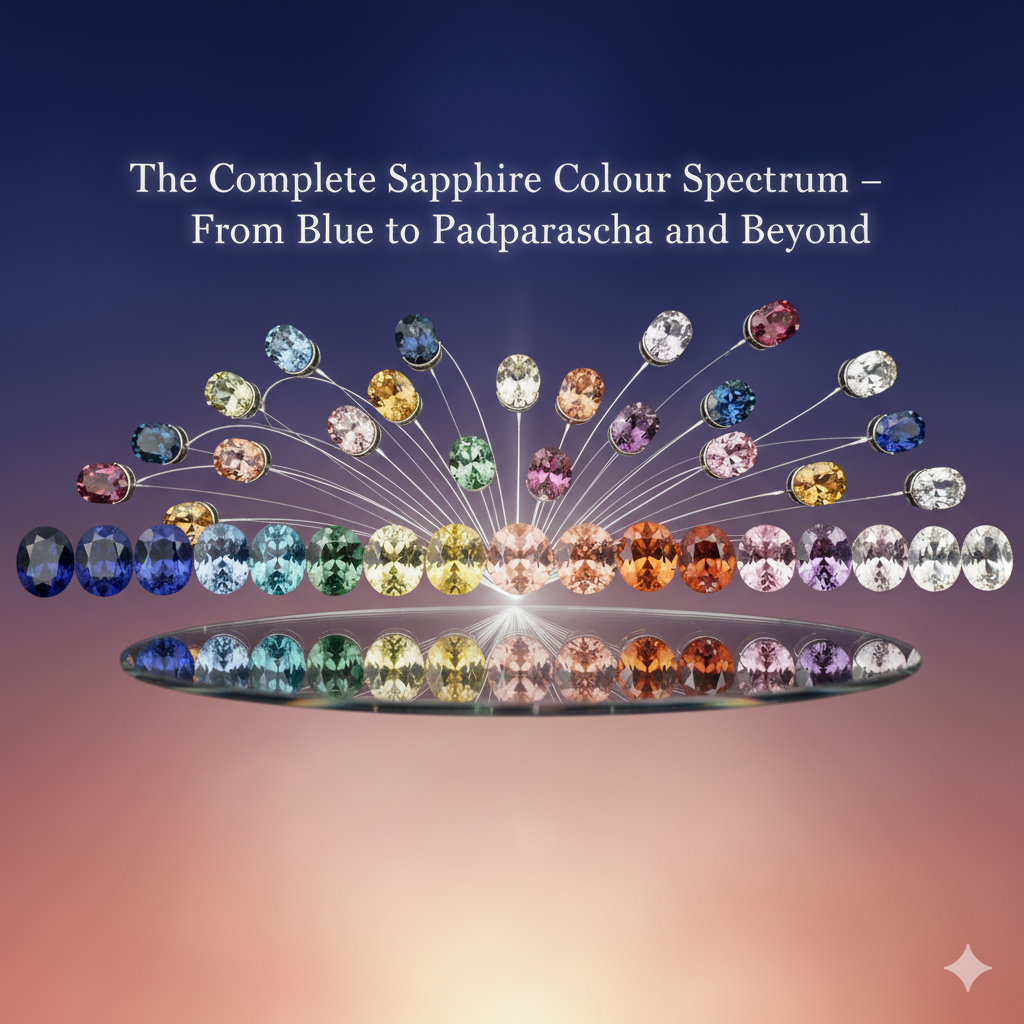Introduction
When most people hear the word ‘sapphire,’ they think of a brilliant royal blue stone. But in truth, sapphires span nearly the entire rainbow. From radiant yellows and pastel pinks to rare Padparadscha blends of pink-orange, sapphires are among the most diverse gemstones in the world. This colour diversity is what makes them prized not only in fine jewellery but also in Vedic astrology and healing traditions.
Scientifically, all sapphires belong to the mineral family ‘corundum,’ composed of aluminium oxide. What differentiates the colours are trace elements such as iron, titanium, chromium, or vanadium. Depending on the presence and balance of these elements, sapphires display a breathtaking spectrum of hues. This blog explores the sapphire colour spectrum in depth — gemmology, history, astrological connections, market values, and buyer tips — to help you understand why sapphires are truly nature’s canvas of colours.
The Science Behind Sapphire Colours
Sapphires are a variety of corundum, second only to diamond in hardness. Pure corundum is colourless, but when trace elements infiltrate its crystal lattice, they create colour. For example:
– Blue sapphires gain their colour from iron and titanium.
– Yellow sapphires owe their colour to iron alone.
– Pink sapphires derive their hue from chromium.
– Padparadscha sapphires balance chromium and iron to produce their rare lotus-like pink-orange.
– Green sapphires come from overlapping bands of blue and yellow caused by multiple trace elements.
Treatments also influence colour. Heat treatment can intensify blue and yellow tones or remove undesirable brownish tints. Diffusion treatment introduces artificial elements into the sapphire’s surface to simulate rare hues. Untreated, natural-colour sapphires are rarer and command far higher prices.
Inclusions also affect how colour appears. Kashmir sapphires, for example, owe their velvety glow to microscopic rutile inclusions known as ‘silk.’ Sri Lankan stones, on the other hand, are prized for their brilliance and lighter tones. Understanding these scientific foundations is key to appreciating the sapphire spectrum.
Blue Sapphire – The Classic Neelam
Blue sapphires are the most iconic and widely recognized members of the sapphire family. Their shades range from the lightest sky blue to deep midnight and velvety royal blues. Origin is crucial in determining value:
– Kashmir: Famous for their cornflower blue with velvety texture. The most prized sapphires in the world.
– Burma (Myanmar): Rich royal blues with exceptional glow.
– Sri Lanka (Ceylon): Known for bright, brilliant, lighter cornflower blues.
– Madagascar: Modern deposits producing vivid, slightly tealish blues.
– Montana (USA): Distinct steel-blue and teal colours.
– Australia: Dark, inky blues, often more affordable.
Astrologically, Blue Sapphire (Neelam) is ruled by Saturn (Shani). It is said to bring discipline, structure, and sudden transformation. But it can also be harsh if Saturn is malefic in one’s chart. For this reason, Neelam is considered one of the most powerful yet sensitive gemstones in Vedic astrology.
Yellow Sapphire – The Pukhraj
Yellow sapphires come in shades from pale lemon and honey to golden canary hues. Origins include Sri Lanka, Madagascar, Nigeria, and Australia. High-quality Sri Lankan yellow sapphires with rich, golden tones are the most valued.
In astrology, Yellow Sapphire (Pukhraj) is associated with Jupiter (Guru). It is worn for wisdom, prosperity, marriage stability, and spiritual growth. Unlike Neelam, Pukhraj is considered safe for most wearers and is a staple recommendation in Vedic gemstone prescriptions.
Pink Sapphire – Romance in Colour
Pink sapphires vary from soft baby pink to intense fuchsia. Sri Lanka and Madagascar are leading sources, while Burma also produces fine pinks. Gem traders often debate where ‘pink sapphire’ ends and ‘ruby’ begins, as both are chromium-coloured corundum. Generally, the distinction is based on saturation — deep red stones are rubies, while lighter or pastel shades are pink sapphires.
Metaphysically, pink sapphires represent love, compassion, and feminine energy. They are often recommended in healing for emotional clarity and relationships.
Padparadscha – The Lotus Blossom Sapphire
Padparadscha sapphires are among the rarest and most prized gems in the world. Their colour is a delicate balance of pink and orange, reminiscent of a lotus flower at sunset. True Padparadscha sapphires are historically found in Sri Lanka, but Madagascar also produces stones with similar hues.
Due to their rarity, Padparadscha sapphires often command prices equal to or exceeding fine blue sapphires. Their romantic, exotic appeal makes them a favourite for high-value collectors.
White Sapphire – The Diamond Alternative
White sapphires are colourless corundum, resembling diamonds but at more affordable prices. Their brilliance is softer, lacking the fire of a diamond, but they are durable and beautiful. In Vedic astrology, White Sapphire (Safed Pukhraj) is associated with Venus (Shukra). It is recommended as an alternative to diamonds, believed to enhance charm, luxury, and relationships.
Green Sapphire – Balance and Harmony
Green sapphires are relatively less known but increasingly popular. Shades range from mint and olive to deeper forest greens. Origins include Sri Lanka, Madagascar, and Australia. Their unique colour is caused by overlapping blue and yellow colour zones. Metaphysically, they are believed to bring calm, balance, and prosperity.
Purple and Violet Sapphires
Purple and violet sapphires occur due to vanadium or chromium presence. They range from soft lavender to deep violet. Many display colour-change properties, appearing bluish in daylight and purplish in incandescent light. These gems are particularly attractive for collectors who value rarity and unique colour play.
Orange Sapphires
Orange sapphires, though not as famous as blues and yellows, hold their own charm. Shades range from light peach to vibrant orange. Origins include Sri Lanka and Madagascar. They are associated with joy, vitality, and courage in metaphysical traditions.
Teal and Bi-colour Sapphires
Teal sapphires, displaying a mix of blue and green, have become very fashionable in modern jewellery. Parti-colour sapphires, often from Australia and Montana, show multiple colours in one stone, such as blue, green, and yellow zones. These stones celebrate individuality and are increasingly popular in engagement rings for those seeking non-traditional gemstones.
Black and Grey Sapphires
Black and grey sapphires are often overlooked due to their opaque appearance. However, they are affordable and durable, making them suitable for bold jewellery designs. In talismanic traditions, they are considered protective stones, warding off negativity and grounding energy.
Star Sapphires – Mystical Asterism
Star sapphires display a star-like pattern, called asterism, caused by rutile inclusions. When cut as cabochons, these stones reveal a 6-rayed or even 12-rayed star that seems to glide across the surface. Star sapphires come in blue, black, grey, pink, and purple. Historically, they have been regarded as powerful talismans offering protection and guidance.
History and Cultural Symbolism of Sapphires
Throughout history, sapphires have been symbols of wisdom, royalty, and spirituality. Ancient Persians believed the Earth rested on a giant sapphire, which gave the sky its blue colour. In Christian tradition, sapphires were associated with heaven and purity. Mughal emperors adorned their courts with sapphires, while European royalty made them symbols of fidelity and nobility.
Today, sapphires remain central to crown jewels across the world — from the British royal family’s engagement rings to ceremonial relics in Asia.
Market and Value Spectrum
Sapphire prices vary dramatically based on colour, origin, treatment, and size. Kashmir sapphires can command prices exceeding $100,000 per carat, while treated commercial sapphires may cost under $50 per carat. Among fancy colours, Padparadscha commands premium pricing, followed by fine pink and vivid yellow sapphires. Untreated stones with certifications (from GRS, SSEF, or GIA) are considered the gold standard.
In terms of investment, sapphires are increasingly popular due to their durability and colour diversity. Collectors value rare colours like Padparadscha, teal, and fine unheated blue the most.
The Astrological Sapphire Spectrum
In Vedic astrology, sapphires are central among Navratna gems:
– Blue Sapphire (Neelam) → Saturn (Shani).
– Yellow Sapphire (Pukhraj) → Jupiter (Guru).
– White Sapphire (Safed Pukhraj) → Venus (Shukra).
Other colours are not part of the classical Navratna system but are still used in contemporary practices. Pink sapphires are sometimes suggested for emotional healing, green for balance, and Padparadscha for creative inspiration. Ultimately, the effectiveness of a sapphire in astrology depends on planetary positions, and gemstone testing before wearing is often recommended.
Buyer’s Guide and Common Myths
When buying sapphires, here are key tips:
– Always ask for certification from a reputed gem lab.
– Be cautious of diffusion-treated stones sold as rare colours.
– Heat treatment is common and acceptable but should be disclosed.
– Untreated sapphires carry premium value.
– Colour should be evaluated under multiple lighting conditions.
Common myths include calling yellow sapphires ‘Oriental Topaz’ or mistaking synthetic sapphires for natural. Another misconception is that all sapphires must be blue — the colour spectrum proves otherwise.
Conclusion
The sapphire colour spectrum is one of the most fascinating in the gemstone world. From the classic blue Neelam to the ethereal Padparadscha and modern teal varieties, sapphires embody a universe of beauty and meaning. Their blend of gemmological intrigue, astrological importance, and cultural symbolism makes them timeless. Whether you seek a gemstone for fashion, investment, or spiritual purpose, there is a sapphire hue that resonates with every soul.
As with all gems, authenticity and emotional connection matter most. A sapphire’s colour is not just an aesthetic choice but a reflection of personality, destiny, and energy.

